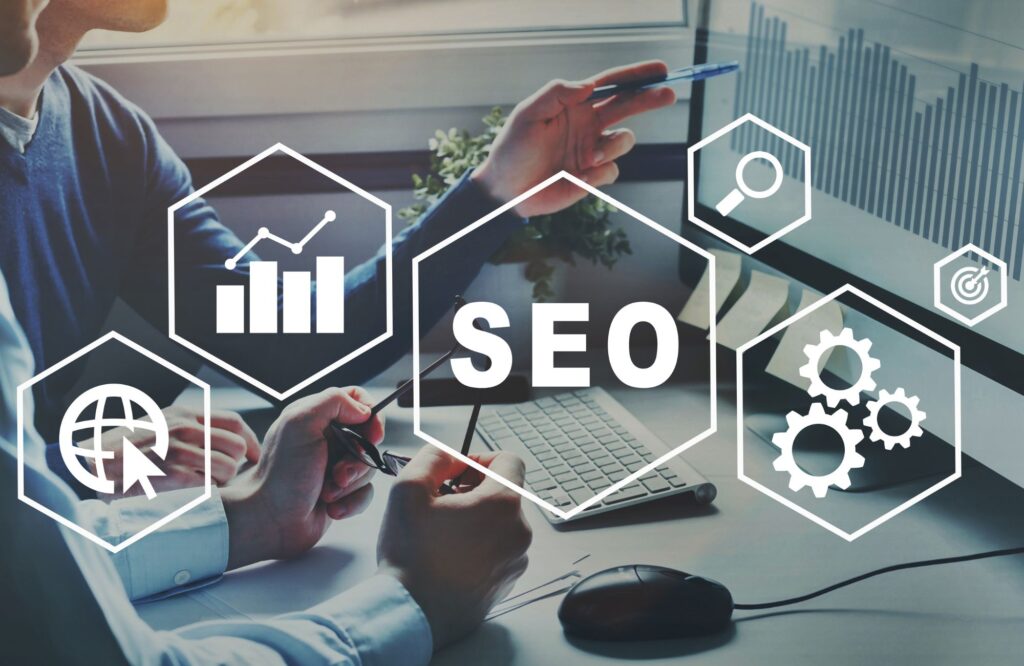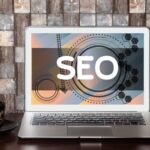On page SEO (or on-site SEO) is the practice of optimizing webpages so search engines and users can better understand, index, and engage with them. Unlike off-page SEO, which relies on backlinks and external signals, on-page SEO gives you direct control over how well your pages align with search intent and ranking factors. In 2025, this matters more than ever as Google rewards content that is keyword-relevant, user-friendly, and structured for AI-driven platforms. Clean HTML, optimized title tags, strong internal links, and high-quality content all improve visibility in search results. Done well, on-page SEO helps businesses of all sizes attract more organic traffic and convert visitors into customers.
At ChitChat Marketing, we’ve seen how a strategic approach to on-page optimization can transform rankings for professional practices and small businesses competing with bigger brands. Beyond core SEO, we also specialize in niche solutions like ABA Therapy SEO to help clinics attract more local clients and ABA Recruitment services to support growth with high-quality staff. Below, we’ll explore actionable steps, real-world examples, and proven tactics to help your pages stand out.
What Is On-Page SEO?
On-page SEO is the process of optimizing elements within your own webpages, content, structure, and technical tags to improve rankings and provide value to users. Unlike off-page SEO, which relies on external signals such as backlinks, on-page SEO is entirely under your control.
Quick comparison:
| Factor | On-Page SEO | Off-Page SEO | Technical SEO |
|---|---|---|---|
| Focus | Content & page elements | Backlinks & external mentions | Crawlability & site performance |
| Examples | Title tags, meta descriptions, URLs | Link building, PR, social sharing | Site speed, XML sitemaps, HTTPS |
| Goal | Relevance + user experience | Authority + trust | Accessibility + stability |
In short, on-page SEO refers to the optimization of individual web pages so that both users and search engines understand and trust the content.
Why On-Page SEO Matters
On-page SEO is important because it signals to search engines whether your webpage matches a user’s query. Search engines prioritize relevance, clarity, and usability when deciding which results to display.
Well-optimized on-page elements improve:
- Search engine rankings – Clear title tags, structured content, and targeted keywords increase visibility.
- User experience – Fast-loading pages and compelling meta descriptions keep visitors engaged.
- Conversions – Pages that match search intent are more likely to convert visitors into customers.
Google’s evolving algorithm still values fundamentals like title tags and headings, but now heavily weighs user-first content. That means focusing on valuable, intent-driven content supported by solid on-page SEO factors is one of the most effective ways to grow organic traffic.
Core Elements of On-Page SEO
Before you can improve rankings, you need to understand the building blocks of on-page SEO. These core elements, from title tags to content optimization, help search engines interpret your pages and ensure users get the right information.
Title Tags
Title tags remain one of the most important on-page SEO elements. They appear in search results, browser tabs, and previews when links are shared.
When writing title tags, keep them between 50–60 characters so they display properly in search results. Make sure to include your focus keyword to align with search intent. To boost clicks, use action-oriented modifiers like “guide,” “checklist,” or “tips” that make the title more compelling and relevant to users.
Meta Descriptions
Meta descriptions don’t directly influence rankings but strongly affect click-through rates. A compelling meta description can mean the difference between a click and a scroll past.
When writing meta descriptions, keep the length between 150–160 characters, or closer to 120 for mobile, to ensure they display correctly in search results. Always match the description to the user’s search intent and include your target keyword for relevance. Use active voice and finish with a clear call to action to encourage clicks.
Headings and Subheadings
Header tags (H1, H2, H3) organize your content so readers can easily scan it, while also helping search engines understand the hierarchy of information on the page. Each page should include only one H1, which is usually the main page title. H2 and H3 tags should naturally include your target and relevant keywords to reinforce topical relevance. Instead of using vague subheads, make them descriptive and useful so both users and search engines can quickly grasp the value of each section.
Content Quality
High-quality content is the foundation of on-page optimization. Search engines measure whether content is comprehensive, original, and aligned with search intent.
- Provide detailed, unique insights, don’t just echo competitors.
- Use visuals, tables, and examples to add clarity.
- Ensure content satisfies the query fully and keeps readers engaged.
Effective keyword research ensures your content fully answers search queries, while avoiding keyword stuffing that can hurt readability and rankings.
Advanced On-Page SEO Tactics
Once you’ve mastered the basics, advanced on-page SEO tactics can give your site a competitive edge. These strategies focus on refining user experience and signaling deeper authority to search engines.
Internal Linking
Internal links guide both users and search engine crawlers. They pass authority between pages and help define site architecture.
When building an internal linking strategy, use keyword-rich but natural anchor text that flows seamlessly within your content. A hub-and-spoke model works best, where comprehensive pillar pages link out to related blog posts and supporting resources. Make sure every important page on your site is linked from at least one other page, as this improves crawlability, distributes authority, and helps users navigate your site more effectively.
External Linking
Linking to reputable sources builds credibility with readers and signals to search engines that your content is trustworthy.
When adding external links, focus on pointing only to relevant and authoritative sites that strengthen your content’s credibility. Avoid excessive linking and prioritize quality over quantity to keep your page clean and trustworthy. Always use descriptive anchor text so readers understand exactly what they’ll find when they click a link.
Image Optimization
Optimized images improve page speed, accessibility, and visibility in Google Images. Always use descriptive filenames and alt text so search engines can understand the content of each image. Compressing file sizes is equally important, as it helps improve load times and overall site speed. For an extra boost in performance, implement lazy loading so images only load when users scroll to them.
URL Structure
URLs should be clean, descriptive, and keyword-rich.
- Example: /on-page-seo-guide is better than /blog?id=12345.
- Keep URLs short and easy to remember.
- Avoid unnecessary numbers, dates, or filler words.
Schema Markup
Structured data helps search engines better interpret your content and can generate rich results in the SERPs. To maximize visibility, use schema types such as FAQPage, LocalBusiness, and Article, depending on the page’s purpose. Always validate your markup with Google’s Rich Results Test to ensure accuracy, and apply schema consistently across important service and blog pages for stronger SEO signals.
If you run a clinic or service-based business, applying on-page SEO can be especially challenging without expert guidance. At ChitChat Marketing, we offer ABA Therapy SEO services designed to help providers rank higher in local searches, attract new clients, and strengthen their online visibility. Our tailored strategies ensure your service pages are optimized with the right keywords, structured data, and local signals to deliver measurable results.
User Experience & Core Web Vitals
Google ranks pages based on user experience signals such as speed, mobile responsiveness, and layout stability. These Core Web Vitals measure performance:
- Largest Contentful Paint (LCP): How fast the main content loads.
- First Input Delay (FID): How quickly the page responds to a user’s action.
- Cumulative Layout Shift (CLS): How stable the layout is during loading.
Improving these factors not only supports rankings but also keeps visitors on your site longer. Tools like Google PageSpeed Insights and Google Search Console can help identify and fix performance issues.
Part of establishing trust and authority includes optimizing onsite elements as well as your organization’s reputation, both with clients and with prospective staff. Our ABA Recruitment approach ensures your clinic’s online profile attracts not only clients but also high-quality applicants.
Optimizing Content for AI & Zero-Click Search
Featured snippets and AI Overviews often provide quick answers to search queries without requiring a click. To optimize for these:
- Start each section with a direct, 40–50-word summary.
- Use declarative sentences like “On-page SEO is…” or “The best way to…”
- Add FAQ sections that address common search queries.
- Break down content into semantic chunks that AI can easily summarize.
Featured snippets often appear at the top of Google Search, pulling quick answers directly from optimized content. Additionally, emphasize EEAT by including author bios, case studies, or expert quotes. Google rewards trustworthy content.
Creating a Practical On-Page SEO Checklist
On-page SEO refers to optimizing individual web pages so search engines and users can easily understand their content. Having a structured page SEO checklist ensures you consistently apply the most important on-page factors across all the pages of your website. This helps search engines understand the context of each particular page and improves your visibility in search engine results pages (SERPs).
Here are a few tips when building your checklist:
- Meta title and meta description: Write a unique, compelling meta description and meta title that summarize your webpage content. Tags and meta descriptions help search engines and users quickly decide if your result matches their search intent.
- Header tags and HTML elements: Use H1 for your page title and H2/H3 subheadings to break down your content. Proper use of HTML elements creates a structure that search engine bots rely on to crawl and index pages.
- Internal and external links: Adding internal links to relevant pages improves site navigation, while external links to other sites build authority. Aim for relevant links that enhance your page content.
- Image optimization: Always add descriptive alt text to images and consider how they may rank in Google Image Search. Optimizing for image search drives additional organic traffic.
Why a Checklist Helps With Consistency
Without a checklist, it’s easy to miss critical steps such as adding a good meta description, checking keyword density, or making sure your focus keyword is included in the page title. A checklist ensures that all the important on-page factors are covered before publishing, from optimizing individual web pages to linking to relevant pages.
For example, blog posts that include structured data, descriptive meta tags, and consistent NAP details (name, address, phone) tend to perform better because search engines and users immediately see the content’s value. A repeatable process helps you maintain high-quality content across your entire site, whether you’re optimizing product pages, service pages, or informational articles.
Conclusion
On-page SEO is one of the most controllable, impactful parts of a digital marketing strategy. By optimizing elements like title tags, meta descriptions, content structure, and schema markup, you can boost visibility, improve user experience, and increase conversions. It’s not a one-time task but an ongoing process, especially as Google’s algorithms and AI search evolve. A consistent on-page SEO strategy allows you to build organic traffic and long-term credibility.
At ChitChat Marketing, we specialize in building SEO strategies that balance all three pillars, on-page, off-page, and technical, so your business can stand out in competitive search results. Beyond core SEO, we also offer specialized services like ABA Therapy SEO to help clinics rank locally and ABA Recruitment to support hiring needs. Ready to take the next step toward stronger rankings and more organic traffic? Contact us today for an SEO strategy session.
FAQs
What is on-page SEO?
On-page SEO is the process of optimizing individual web pages, titles, content, images, and internal links to improve rankings in search engine results pages. It ensures that both users and search engines can understand and trust your content.
What are the 4 types of SEO?
The four main types of SEO are on-page SEO, off-page SEO, technical SEO, and local SEO. Each focuses on different elements of improving visibility and rankings. A complete SEO strategy balances all four to achieve sustainable results.
What is on-site SEO and off-site SEO?
On-site SEO (or on-page SEO) refers to optimizations made within your own pages, such as title tags, meta descriptions, and content. Off-site SEO involves external signals like backlinks, PR, and social mentions that build authority.
What is off-page SEO?
Off-page SEO refers to actions taken outside of your own website to improve search rankings. This includes building backlinks, guest posting, brand mentions, and social media marketing. Unlike on-page SEO, these factors are less within your direct control.




